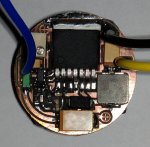- Joined
- Mar 18, 2012
- Messages
- 173
- Points
- 0
Here is my new high power and thermally efficient boost driver:
- insulated aluminum substrate (IMS) PCB for exceptional thermal efficiency
- current output exceed 2.5A
- very high precision current control and multi-tourn trimmer
- grounded load (only 1 wire to connect)
- open and short load protection
The PCB can be connected directly to the heatsink to obtain a perfect thermal contact.
The board is currently under tests and performs very well. :yh:
It is possible to make commercial boards if anyone interested.



- insulated aluminum substrate (IMS) PCB for exceptional thermal efficiency
- current output exceed 2.5A
- very high precision current control and multi-tourn trimmer
- grounded load (only 1 wire to connect)
- open and short load protection
The PCB can be connected directly to the heatsink to obtain a perfect thermal contact.
The board is currently under tests and performs very well. :yh:
It is possible to make commercial boards if anyone interested.



Attachments
Last edited:










